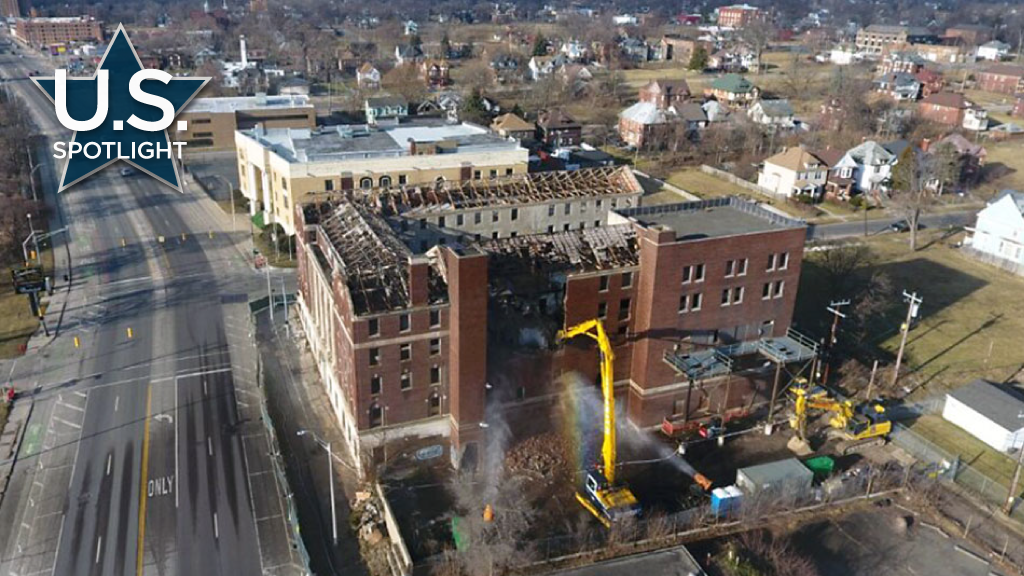The Detroit demolition department marked its 100th commercial demolition within one year in early February, the largest scale demolition program of any city in America.
The Motor City, known for its industrial might but also recent decade’s blight, has embarked on both major residential and commercial demolitions in an effort to rid the city of unsightly properties and make it safer for residents.
Some 5,500 residential properties have come down but the commercial property demolitions have emerged with vigor over the past year, as the city takes advantage of $86 million in federal American Rescue Plan Act funds to attack all manner of former derelict enterprises, from mom and pop shops, gas stations to school buildings and industrial manufacturing plants.
One of the larger ones commenced Feb. 12, with a high reach excavator slicing away at walks of the once venerable Hannan Memorial YMCA on Detroit’s east side along busy Jefferson Boulevard.
The demolition program is relatively new with the city’s department only established in 2021.
For department director LaJuan Counts, it’s par for the course after an elementary school on the northwest side went under the proverbial hammer the previous week.
But there is a difference between demolishing a home and demolishing what was for generations a business.
“In the commercial sense, we’re never quite sure in the beginning when we take on a property what its use had been throughout the lifespan or history,” she said.
A bookstore may have earlier been a dry cleaner with storage tanks underneath.
“We don’t find that out until they start to do the environmental survey work,” she said. “And so the environmentals become really a crucial part of the pre-demo work that has to happen for us to make sure we’re demolishing structures that we’ve taken every precaution on before the demo actually starts.”
The buildings are both publicly and privately owned. What determines their mandate for demolition is inspections by the city’s building department. If privately owned the city will charge the owner.
“We have quite an aggressive cost recovery program in which we go after those private owners for reimbursement of our demolition costs,” Counts said.

The city has no yearly demolition budget but is establishing one “so we don’t have backlog of commercial demos that are stockpiled and then we have to wait for some pile of money to come in for us to address them,” she said.
Other determining factors are safety and incidents that may have taken place at the building, Counts said, as well as the “marketability” of the location for redevelopment. Another factor is the buildings have been vacant so long it simply would cost too much to rehab them.
Counts said Detroit’s program is the largest in the U.S. Talking with building officials in other cities, “I’ve yet to come across even another city that’s even had a past demo program as large as ours.”
Contractors are chosen from pre-qualified lists. They’re usually assigned based on size or complexity. A company could obtain a package of seven or eight similar properties. On the residential side, typically 120 houses are packaged.
Targeted structures vary widely, from gas stations to the current largest project, the former Packard auto manufacturing plant, a mammoth hulk in the center of the city.
Likewise, some buildings take as few as “six minutes” to demolish, Counts said, while Packard is taking months.
Typically though it takes a couple of weeks and then similar times to do the load out and establish final grade.
Prior to demolition the city works closely with the surrounding communities, a major commitment in light of a history of “significant sense of distrust,” Counts said.
Field teams meet with residents, including placing “door hangers” on all residences notifying three to 14 days prior, and are on sight supervising the private contractors’ work.
“We just want to make sure that they’re very clear as to what’s going on in their communities and they have absolutely all the information that we have about those properties,” she said.
The city will also abate buildings and always uses the “Wet-Wet-Wet” demo method.
Challenges can be unique to properties but, for residential particularly, getting excavation equipment down narrow streets can pose difficulties. Not to mention house separation of five or six feet.
“So just proximity usually becomes the biggest issue for us,” Counts said.











Recent Comments